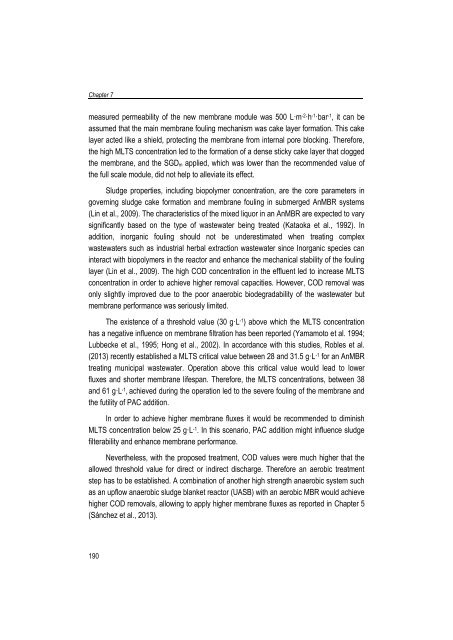Combining submerged membrane technology with anaerobic and ...
Combining submerged membrane technology with anaerobic and ...
Combining submerged membrane technology with anaerobic and ...
You also want an ePaper? Increase the reach of your titles
YUMPU automatically turns print PDFs into web optimized ePapers that Google loves.
Chapter 7measured permeability of the new <strong>membrane</strong> module was 500 L·m -2·h -1·bar -1 , it can beassumed that the main <strong>membrane</strong> fouling mechanism was cake layer formation. This cakelayer acted like a shield, protecting the <strong>membrane</strong> from internal pore blocking. Therefore,the high MLTS concentration led to the formation of a dense sticky cake layer that cloggedthe <strong>membrane</strong>, <strong>and</strong> the SGD m applied, which was lower than the recommended value ofthe full scale module, did not help to alleviate its effect.Sludge properties, including biopolymer concentration, are the core parameters ingoverning sludge cake formation <strong>and</strong> <strong>membrane</strong> fouling in <strong>submerged</strong> AnMBR systems(Lin et al., 2009). The characteristics of the mixed liquor in an AnMBR are expected to varysignificantly based on the type of wastewater being treated (Kataoka et al., 1992). Inaddition, inorganic fouling should not be underestimated when treating complexwastewaters such as industrial herbal extraction wastewater since Inorganic species caninteract <strong>with</strong> biopolymers in the reactor <strong>and</strong> enhance the mechanical stability of the foulinglayer (Lin et al., 2009). The high COD concentration in the effluent led to increase MLTSconcentration in order to achieve higher removal capacities. However, COD removal wasonly slightly improved due to the poor <strong>anaerobic</strong> biodegradability of the wastewater but<strong>membrane</strong> performance was seriously limited.The existence of a threshold value (30 g·L -1 ) above which the MLTS concentrationhas a negative influence on <strong>membrane</strong> filtration has been reported (Yamamoto et al. 1994;Lubbecke et al., 1995; Hong et al., 2002). In accordance <strong>with</strong> this studies, Robles et al.(2013) recently established a MLTS critical value between 28 <strong>and</strong> 31.5 g·L -1 for an AnMBRtreating municipal wastewater. Operation above this critical value would lead to lowerfluxes <strong>and</strong> shorter <strong>membrane</strong> lifespan. Therefore, the MLTS concentrations, between 38<strong>and</strong> 61 g·L -1 , achieved during the operation led to the severe fouling of the <strong>membrane</strong> <strong>and</strong>the futility of PAC addition.In order to achieve higher <strong>membrane</strong> fluxes it would be recommended to diminishMLTS concentration below 25 g·L -1 . In this scenario, PAC addition might influence sludgefilterability <strong>and</strong> enhance <strong>membrane</strong> performance.Nevertheless, <strong>with</strong> the proposed treatment, COD values were much higher that theallowed threshold value for direct or indirect discharge. Therefore an aerobic treatmentstep has to be established. A combination of another high strength <strong>anaerobic</strong> system suchas an upflow <strong>anaerobic</strong> sludge blanket reactor (UASB) <strong>with</strong> an aerobic MBR would achievehigher COD removals, allowing to apply higher <strong>membrane</strong> fluxes as reported in Chapter 5(Sánchez et al., 2013).190
















